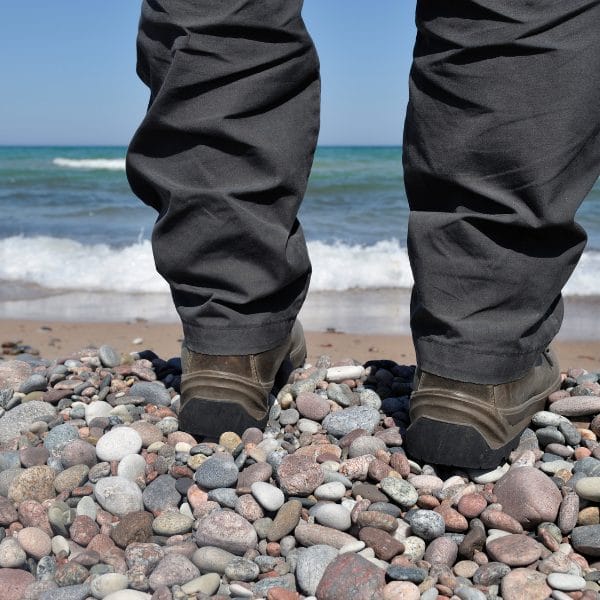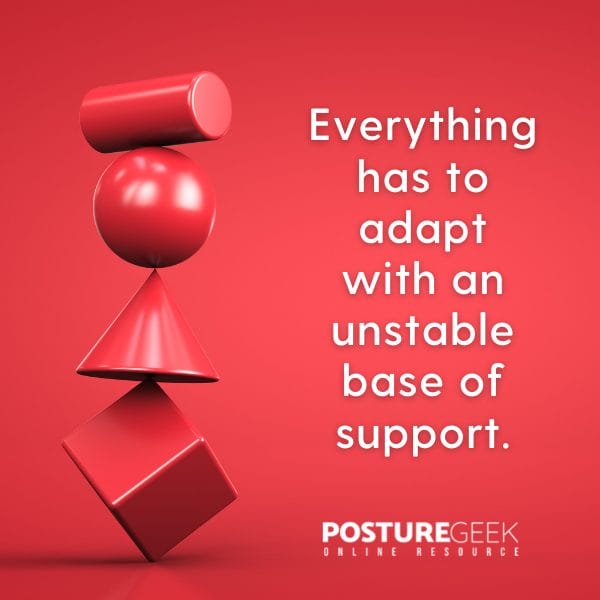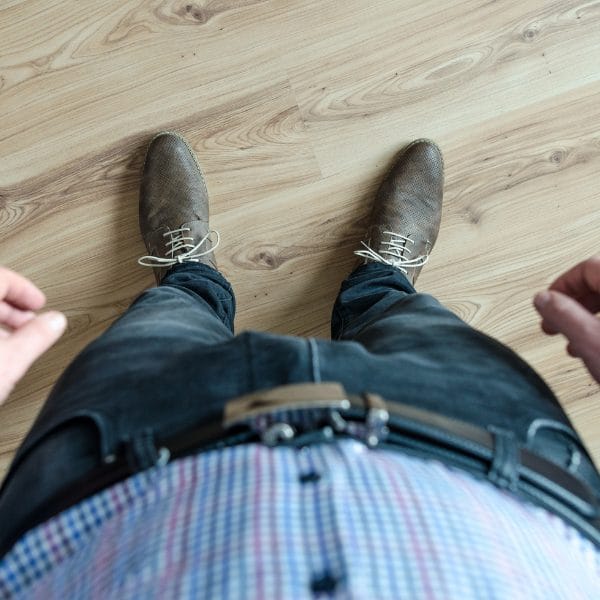Finding Your Base of Support: The Foundation Of Health And Posture.
- Updated - March 26, 2025
The base of support is the foundation on which your body stands. It is also the foundation of your health and posture. For example, your feet are designed to provide a stable platform that distributes weight evenly. Still, many people don’t know how to do this correctly. This article will delve into what the base of support means for you, why it’s essential, and how you can find it in order to have better health!
The base of support is the foundation on which your body stands. It is also the foundation of your health and posture.
PostureGeek.com Tweet
Why a Strong Base of Support Matters for Your Posture

When we traditionally consider the base of support, we describe the relationship of feet to the ground and its impact on all body regions above it. In theory, the larger the support base, the greater stability you will experience. For example, watch a wrestler stand with feet apart and bent at the hips. This wide stance provides support and strength for any possible movement required. On the other end, you have the example of someone balancing on one leg – like a stork. This base of support will be narrow and consequently relatively unstable.
In this new context, however, the area we use to describe the ‘Base of Support’ can also extend to our feet, hands, head, or any other part of our body that makes contact with the ground – with the goal to create support and overall stability. The base of support is the area beneath a person that encompasses every point of contact that the person makes with the supporting surface.
A stable base encompasses your feet and allows your body to evenly distribute weight bearing through your base, supporting all joints and limbs. Your base also impacts how you stand and walk, so athletes like runners or dancers need to be mindful of their base.
If you notice that you’re shifting weight around while standing or walking or if there is an uneven distribution of pressure on different areas while standing, then it’s likely that your base isn’t completely stable and needs work adjusting to distribute weight more evenly throughout the skeleton.
As you can see, the support from below is significant for health and posture.
How can you find your base of support?

You can find your base of support by recognizing the weight distribution of your body and allowing for equal distribution. The nature of the supporting surface; whether it’s the ground, a chair, or assistive devices can significantly affect your stability and balance. This support should be felt from the hips all the way down to your feet. Suppose you are feeling off-balance or notice a shift in weight. In that case, it may mean something wrong with your base that needs work adjusting to distribute weight more evenly throughout your skeleton.
Figuring out how to find this base can take some time, though! If you spend a lot of time sitting, it can be more difficult to feel where your base is and what that means for weight distribution. Getting up frequently, stretching, or practising yoga are excellent ways to get in tune with your base of support and distribute pressure evenly throughout!
What happens with a wider base of support?

A wider base of support can help reduce balance issues and the risk of tripping unexpectedly. Positioning your feet at shoulder width distance can significantly affect stability, as a wider stance generally provides better balance and safety during various activities. In addition, with a wider base, you can provide a stable platform that distributes weight evenly.
When your base is broader, you can support more weight without physical stress. This makes it easier to carry large objects or walk with a backpack for longer distances since the load will be distributed evenly through each point of contact on the body.
However, having too wide of a base can also have negative consequences. For example, someone with too wide of a base might move less efficiently or have more trouble making quick movements since they’re not used to instability. Additionally, having a wider base can make it harder to balance in some cases.
Discover a practitioner near you.
Looking for a practitioner near you? Our extensive network of qualified professionals is here to help you.
How can lack of support from below have an impact throughout the body?

As we’ve discussed, your base of support is essential for distributing weight evenly throughout the body. However, when this base is unstable or not in alignment, it can cause pain and discomfort in other parts of the body. Postural instability can exacerbate this issue, leading to further pain and discomfort as the body struggles to maintain balance.
For example, if you’re struggling to find your base of support, you may notice that you’re constantly putting more weight on one side than the other.
This can lead to knee, hip, and back pain, as those areas always bear more weight than they should be.
In addition, an unstable base of support can also lead to poor posture, which can cause even more pain and discomfort in the long run.
So how can you ensure that your base of support is stable and in line?
Try to keep your weight evenly distributed when standing or walking. This will create a more stable foundation.
PostureGeek.com Tweet

There are a few things you can do to help find and maintain a stable base of support:
- Make sure your feet are parallel when standing. This will provide more stability.
- When squatting, make sure that your heels stay in contact with the ground at all times. If they start to lift up, you’re no longer in a squatting position and are putting more pressure on the front points of your base of support.
- Try to keep your weight evenly distributed when standing or walking. This will create a more stable foundation.
- Practice some balance exercises! This will help improve your stability and alignment.
How does your base of support affect dynamic stability in athletes?
Having a solid base of support is vital for athletes, as it allows them to maintain good form and avoid injury. It is also important to perform exercises that integrate both static and dynamic balance to improve overall stability and reduce the risk of falls.
When you’re running or dancing, for example, a stable base is essential to keep you upright and move in the right direction.
Conversely, a base that is too wide or unstable can, in certain circumstances, cause you to lose balance and fall.
A base of support that is too narrow, on the other hand, can also be dangerous. For example, when you’re playing soccer or football, and someone tackles you from behind, it’s essential to have a wide base for stability so your weight doesn’t end up in one area.
If your base is too small or unstable, this could cause you to break your fall dangerously, leading to injuries.
Can flat feet affect a stable base of support and postural control?
Flat feet can affect a base of support because it can be difficult to distribute their weight evenly. When someone has flat feet, they may not feel how support from below has been impacted. In addition, this uneven foot positioning may affect how the legs work together. As a result, they may not be able to distribute weight evenly. Orthotics can be a consideration if flat feet become an issue.
How can the base of support be improved?
Many people have trouble finding and maintaining their base of support because they don’t practice it or pay attention to when their base is out of alignment. Several modalities, including Physical therapy can offer targeted interventions that help individuals develop better balance and reduce the risk of falls. This is especially true with the growing popularity of sitting at work all day, which can wreak havoc on your base of support.
Finding a recognized health care provider can assist you in developing the necessary awareness and strength. In addition, seeking professional assistance provides another layer in developing your stable base of support.
What base of support is best for children?

Young kids should be taught how to find and maintain a stable base of support early. This base will provide them necessary skills to distribute their weight evenly throughout their body, which means better posture!
When teaching young children, it’s also important to emphasize that they shouldn’t stand with their feet too close together or too far apart. A base with too wide a support can be just as dangerous as one that’s too narrow. The key here is making sure that their base feels stable throughout while also distributing weight evenly from left to right and front to back.
How does your base of support affect your stable posture?
The base is an excellent indicator of how well you stand and walk, which in turn impacts your overall posture!
PostureGeek.com Tweet
Your base of support affects your posture in several ways.
First, your base needs to distribute weight evenly throughout your kinetic chain because this helps you maintain good posture and avoid injury. Second, having a solid base means that you will have better balance when standing or walking – and therefore, fewer falls. Finally, an unstable base can impact several sport and recreational activities.
The base is an excellent indicator of how well you stand and walk, which in turn impacts your overall posture! If there are imbalances or specific points aren’t touching the ground as they should be, it could lead to issues down the road. A strong base will provide grounding and support allowing your upper body to remain aligned for improved posture.
The base of support is also what tells us where our center of gravity lies, which affects how we move around in space as well as keeps us balanced when standing still!
How does gravity impact your base of support?
Gravity has a pretty profound effect on the base of support. In some cases, it counteracts weight-bearing forces and provides stability instead of destabilizing balance. It’s essential to be aware of how gravity affects your base and make necessary adjustments. For example, suppose you’re standing on an uneven surface. In that case, your base of support may shift to compensate for the imbalance, which can lead to falls or injuries.
Motion

A base of support can also have a significant impact on how you move. It’s the base from which we push off to walk, run, dance, or move in any direction. If it is too wide or narrow, our motions will be compromised and potentially dangerous.
The base of support tells us where our center of gravity lies, which affects how we move around in space and keeps us balanced when standing still!
For both young and old a stable base of support, it’s also important to emphasize that you shouldn’t stand with feet too close together or too far apart. A base of too wide support can be just as dangerous as one that’s too narrow. The key here is making sure that your base of support is in the right spot for your specific activity.
What do we mean by motion?
A base of support will differ depending on need.
PostureGeek.com Tweet

Motion is the movement of an object from one point to another. It can be linear or rotational. Linear motion is movement in a straight line, while rotational motion is when an object moves around an axis.
The base of support plays a significant role in motion because it dictates where you need to be to complete that movement.
If your base is too wide or narrow, your movement won’t adjust correctly and could lead to injuries.
Once again, children need to learn about their available support base during sports activities to understand this concept to move safely.
What does the base of support mean for your health?
A stable base helps to keep all joints and limbs in line, reducing wear and tear on the body and preventing pain or injury.
PostureGeek.com Tweet

Our base of support means different things for different people. For athletes, it’s crucial to have a stable base to reduce the risk of injury. For pregnant women, protecting and strengthening the base is essential in preventing back pain. For elderly individuals, having a solid base can help prevent falls and injuries.
But, for everyone, having a strong base of support is important in maintaining good health.
A stable base helps to keep all joints and limbs in line, reducing wear and tear on the body and preventing pain or injury.
It also allows your body to move more efficiently without compensating in other areas. This can be extremely helpful for people who are trying to lose weight.
How does your base of support affect walking?
A stable base is fundamental during walking or running, as it provides a stable platform for the feet to push off from. This allows you to generate power and move forward without pausing between steps. When there’s an imbalance with this base, you’re likely to feel unstable while walking or running, which can increase your risk of injury.
Key Takeaways: Why Your Base of Support Deserves More Attention
The base of support is the foundation that we stand and walk on. It’s what tells us where our center of gravity lies, which affects how we move around in space and keeps us balanced when standing still!
A strong base will help to keep your spine in alignment and improve posture. However, if there are imbalances or specific points aren’t touching the ground as they should be, it could lead to issues down the road.
Our base of support is also what tells you where your weight-bearing forces are being distributed. So make sure to stay aware of any suspicions about imbalance happening at different stages in life.
Having a strong base of support is important in maintaining good health!
Thanks for reading!
Please feel free to leave any comments or questions below. I always love hearing from you all! 🙂
FAQ: Understanding Your Base of Support
What is base of support in posture?
Your base of support is the area beneath your body that makes contact with the ground and supports your weight. These are typically your feet when standing, but they can also include your hands, knees, or other body parts, depending on your position. A stable base allows for better posture, balance, and movement.
Why is the base of support important for balance?
A stable base of support provides the foundation for all movement. The wider and more evenly distributed the base, the more balance and control you’ll have during activities like standing, walking, or exercising. An unstable base increases the risk of falls, injury, or compensations elsewhere in the body.
How can I improve my support base?
You can improve your base of support by:
- Practicing proper standing alignment with feet hip-width apart
- Doing balance exercises like single-leg stands or yoga poses
- Wearing supportive footwear (especially if you have flat feet)
- Seeing a professional for postural or gait assessments
Can flat feet affect my base of support?
Yes. Flat feet can reduce the natural arches that help evenly distribute weight. This can compromise your base of support and lead to imbalances, strain, and poor posture. Orthotics or exercises to strengthen the feet may help.
What is an ideal base for different activities?
- Standing still: Feet hip-width apart, evenly grounded
- Lifting or squatting: Slightly wider base for stability
- Running or dancing: A dynamic, responsive base with good foot mechanics
- Balance challenges: Narrow or shifting base for training proprioception
Your base of support should adapt to the demands of the activity while remaining stable and connected to the ground.
PLEASE NOTE
PostureGeek.com does not provide medical advice. This information is for educational purposes only and is not intended to be a substitute for professional medical attention. The information provided should not replace the advice and expertise of an accredited health care provider. Any inquiry into your care and any potential impact on your health and wellbeing should be directed to your health care provider. All information is for educational purposes only and is not intended to be a substitute for professional medical care or treatment.
About the author
Find Expert Posture Practitioner Near You
Discover our Posture Focused Practitioner Directory, tailored to connect you with local experts committed to Improving Balance, Reducing Pain, and Enhancing Mobility.
